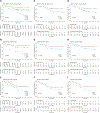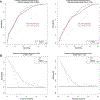Positive STAT5 Protein and Locus Amplification Status Predicts Recurrence after Radical Prostatectomy to Assist Clinical Precision Management of Prostate Cancer
- PMID: 31292140
- PMCID: PMC6774884
- DOI: 10.1158/1055-9965.EPI-18-1358
Positive STAT5 Protein and Locus Amplification Status Predicts Recurrence after Radical Prostatectomy to Assist Clinical Precision Management of Prostate Cancer
Abstract
Background: A significant fraction of prostate cancer patients experience post-radical prostatectomy (RP) biochemical recurrence (BCR). New predictive markers are needed for optimizing postoperative prostate cancer management. STAT5 is an oncogene in prostate cancer that undergoes amplification in 30% of prostate cancers during progression.
Methods: We evaluated the significance of a positive status for nuclear STAT5 protein expression versus STAT5 locus amplification versus combined positive status for both in predicting BCR after RP in 300 patients.
Results: Combined positive STAT5 status was associated with a 45% disadvantage in BCR in Kaplan-Meier survival analysis in all Gleason grade patients. Patients with Gleason grade group (GG) 2 and 3 prostate cancers and combined positive status for STAT5 had a more pronounced disadvantage of 55% to 60% at 7 years after RP in univariate analysis. In multivariate analysis, including the Cancer of the Prostate Risk Assessment Postsurgical nomogram (CAPRA-S) variables, combined positive STAT5 status was independently associated with a shorter BCR-free survival in all Gleason GG patients (HR, 2.34; P = 0.014) and in intermediate Gleason GG 2 or 3 patients (HR, 3.62; P = 0.021). The combined positive STAT5 status improved the predictive value of the CAPRA-S nomogram in both ROC-AUC analysis and in decision curve analysis for BCR.
Conclusions: Combined positive status for STAT5 was independently associated with shorter disease-free survival in univariate analysis and was an independent predictor for BCR in multivariate analysis using the CAPRA-S variables in prostate cancer.
Impact: Our results highlight potential for a novel precision medicine concept based on a pivotal role of STAT5 status in improving selection of prostate cancer patients who are candidates for early adjuvant interventions to reduce the risk of recurrence.
©2019 American Association for Cancer Research.
Conflict of interest statement
Figures



Similar articles
-
Prostate MRI added to CAPRA, MSKCC and Partin cancer nomograms significantly enhances the prediction of adverse findings and biochemical recurrence after radical prostatectomy.PLoS One. 2020 Jul 9;15(7):e0235779. doi: 10.1371/journal.pone.0235779. eCollection 2020. PLoS One. 2020. PMID: 32645056 Free PMC article.
-
Evaluation of biochemical recurrence-free survival after radical prostatectomy by cancer of the prostate risk assessment post-surgical (CAPRA-S) score.Asian Pac J Cancer Prev. 2015;16(6):2527-30. doi: 10.7314/apjcp.2015.16.6.2527. Asian Pac J Cancer Prev. 2015. PMID: 25824791
-
Genetic predisposition to early recurrence in clinically localized prostate cancer.BJU Int. 2013 Apr;111(4):549-58. doi: 10.1111/j.1464-410X.2012.11333.x. Epub 2012 Jul 3. BJU Int. 2013. PMID: 22759231
-
PITX2 methylation: a novel and effective biomarker for monitoring biochemical recurrence risk of prostate cancer.Medicine (Baltimore). 2019 Jan;98(1):e13820. doi: 10.1097/MD.0000000000013820. Medicine (Baltimore). 2019. PMID: 30608394 Free PMC article.
-
Signal transducer and activator of transcription 5a/b: biomarker and therapeutic target in prostate and breast cancer.Int J Biochem Cell Biol. 2011 Oct;43(10):1417-21. doi: 10.1016/j.biocel.2011.06.007. Epub 2011 Jun 17. Int J Biochem Cell Biol. 2011. PMID: 21704724 Free PMC article. Review.
Cited by
-
Second-Generation Jak2 Inhibitors for Advanced Prostate Cancer: Are We Ready for Clinical Development?Cancers (Basel). 2021 Oct 17;13(20):5204. doi: 10.3390/cancers13205204. Cancers (Basel). 2021. PMID: 34680353 Free PMC article. Review.
-
Cytokines, JAK-STAT Signaling and Radiation-Induced DNA Repair in Solid Tumors: Novel Opportunities for Radiation Therapy.Int J Biochem Cell Biol. 2020 Oct;127:105827. doi: 10.1016/j.biocel.2020.105827. Epub 2020 Aug 19. Int J Biochem Cell Biol. 2020. PMID: 32822847 Free PMC article. Review.
-
Prospects for Clinical Development of Stat5 Inhibitor IST5-002: High Transcriptomic Specificity in Prostate Cancer and Low Toxicity In Vivo.Cancers (Basel). 2020 Nov 18;12(11):3412. doi: 10.3390/cancers12113412. Cancers (Basel). 2020. PMID: 33217941 Free PMC article.
-
Targeting the JAK/STAT pathway in solid tumors.J Cancer Metastasis Treat. 2020;6:27. Epub 2020 Aug 21. J Cancer Metastasis Treat. 2020. PMID: 33521321 Free PMC article.
-
Mechanism-centric regulatory network identifies NME2 and MYC programs as markers of Enzalutamide resistance in CRPC.Nat Commun. 2024 Jan 8;15(1):352. doi: 10.1038/s41467-024-44686-5. Nat Commun. 2024. PMID: 38191557 Free PMC article.
References
-
- D’Amico AV, Whittington R, Malkowicz SB, Fondurulia J, Chen MH, Tomaszewski JE, et al. The combination of preoperative prostate specific antigen and postoperative pathological findings to predict prostate specific antigen outcome in clinically localized prostate cancer. J Urol 1998;160(6 Pt 1):2096–101. - PubMed
Publication types
MeSH terms
Substances
Grants and funding
LinkOut - more resources
Full Text Sources
Medical
Miscellaneous

